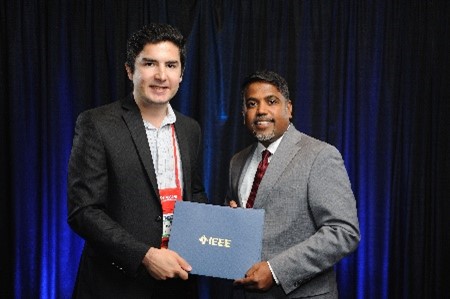Director’s Corner

Greetings! Welcome to the quarterly newsletter from the 3D Systems Packaging Research Center (PRC).
I had an opportunity to lead PRC for 3.5 years starting Mar. 2019. During this period, we developed a partnership with industry and US government that allowed us to triple the number of students working in packaging at PRC. This has led to a multi-disciplinary program supported by a team consisting of students, staff, and faculty with diverse backgrounds coming from electrical & computer engineering, materials science, mechanical engineering, chemical engineering, computer science, industrial engineering, and chemistry. This has helped us in conducting leading edge research in advanced packaging and heterogeneous integration. Today, PRC represents the largest academic center of its kind focused on semiconductor packaging around the world supported by more than 45 semiconductor companies.
It is now time for new leadership to grow the center even more. I will be stepping down as Director PRC effective Dec. 31, 2022, and transitioning to my new role as Department Head of Electrical Engineering, Penn State University starting Jan. 1, 2023. My passion for semiconductor packaging will continue in my new role where I hope to establish another major program in this important area. I look forward to keeping in touch with all of you. Farewell my dear students, faculty, staff, friends, and industry colleagues!
To learn more about PRC, please visit us at www.prc.gatech.edu and also do follow us on linkedin https://www.linkedin.com/company/gt-prc/
We provide below some recent research highlights.
Sincerely,
Madhavan Swaminathan
Research Highlights
NANOCOMPOSITES FOR FUTURE ELECTRONICS DEVICE PACKAGING
With the ultra-fast development of high-performance semiconductor devices, due to increase in power and on-chip integration density, it is essential to maximize heat transfer efficiency and explore new nanomaterials for applications as thermal interface materials (TIMs). Graphene-based epoxy nanocomposites are becoming one of the most promising candidates for the next generation of highly efficient, lightweight TIMs due to the unique properties of graphene with extraordinarily high thermal conductivities and large surface areas. However, they can have poor interfacial interactions with polymers owing to the lack of functional groups on the surface of graphene, leading to phonon scattering within the contact interfaces. The graphene epoxy nanocomposites have an out-of-plane thermal conductivity of 0.73 W/mK at 5 wt% loading, corresponding to a 400% improvement in thermal conductivity as compared to that of neat epoxy. In this work, graphene nanosheets are fabricated by a large-scale and low-cost liquid exfoliation method. PDA and silane modified ex G epoxy nanocomposites have been fabricated, and the fundamental understanding of interfacial connecting mechanisms and the optimal condition of silane coupling agents for PDA-graphene fillers have been studied through several characterization techniques, including TEM, XPS, FTIR, goniometer, and rheometer. From performance tests on the TIMs, Z. Sun et al. present better cooling capabilities and heat dissipation as corroborated through both experimentation and simulation, supporting the idea that the findings have potential to be applied in the next generation of TIMs for high-power and high-density integrated circuits (ICs) as well as in advanced packaging. Read here.

(Left) Schematic of the fabrication process with images from standard characterization methods. (Right) Schematic configuration of TIMs evaluation system.
DIE-EMBEDDED GLASS PACKAGING FOR 6G WIRELESS APPLICATIONS
This work by X. Jia et al., presents the design and fabrication of an antenna-integrated glass package with embedded die for D-band (110–170 GHz) wireless applications. The proposed package uses glass as the core material, in which dies are embedded. The redistribution layer (RDL) for electrical connections is fabricated on low-loss polymeric build-up films (ABF-GL102). The vertical interconnects between the dies and the package are implemented using laser-drilled micro-vias. The RDL supports two metal layers which include an 8-element series-fed microstrip patch antenna array. Using micro-vias and transmission lines integrated into the low-loss polymer, the die-embedded glass package provides low-loss and low-parasitic die-to-die and die-to-antenna interconnects. Read Here.

(Left) Schematic of Die-embedded glass package assembled on a PCB. (Right) RF dies in the glass panel connected to microstrip antenna arrays through microvias.
OPTIMIZATION OF DECOUPLING CAPACITORS FOR POWER DELIVERY
In this article by S. Han et al., a knowledge-based optimization method is proposed to develop an optimized power delivery network (PDN) using the minimum number of decoupling capacitors. In addition, voltage response arising from any arbitrary load current sources that is within the threshold level of noise levels is guaranteed. Unlike recent random search-based methods such as genetic algorithm and machine learning (ML) that require many PDN simulations for learning and selection, the proposed method uses domain knowledge, thereby significantly reducing the number of simulations required. The results show that only 1.3% of the compute time is required to achieve the optimized capacitor design as compared to ML-based method. Read Here.

(Left) Equivalent circuit of PDN; (Middle) PCB layout; (Right) Optimized PDN response with minimum capacitors
Faculty Highlight
 Congratulations to Dr. Yogendra Joshi who joined DARPA in July 2022 as a program manager in the Microsystems Technology Office (MTO). He is a professor and the John M. McKenney and Warren D. Shiver Distinguished Chair at Georgia Institute of Technology’s G.W. Woodruff School of Mechanical Engineering. In addition, he has a courtesy appointment at Georgia Tech’s School of Electrical and Computer Engineering. His research interests are in multi-scale thermal management. Joshi is an elected fellow of ASME, the AAAS, and IEEE. He has been recognized for his contributions through several awards, including the Inventor Recognition Award from the Semiconductor Research Corporation (2001), the IBM Faculty Award (2008), the IIT Kanpur Distinguished Alumnus Award (2011), the AIChE Donald Q. Kern Award (2018), and multiple honors from IEEE and ASM
Congratulations to Dr. Yogendra Joshi who joined DARPA in July 2022 as a program manager in the Microsystems Technology Office (MTO). He is a professor and the John M. McKenney and Warren D. Shiver Distinguished Chair at Georgia Institute of Technology’s G.W. Woodruff School of Mechanical Engineering. In addition, he has a courtesy appointment at Georgia Tech’s School of Electrical and Computer Engineering. His research interests are in multi-scale thermal management. Joshi is an elected fellow of ASME, the AAAS, and IEEE. He has been recognized for his contributions through several awards, including the Inventor Recognition Award from the Semiconductor Research Corporation (2001), the IBM Faculty Award (2008), the IIT Kanpur Distinguished Alumnus Award (2011), the AIChE Donald Q. Kern Award (2018), and multiple honors from IEEE and ASM
 We thank Prof. Christian Schuster, a visiting professor at Georgia Tech from Hamburg University of Technology (TUHH), who presented a short course on “Bioelectromagnetics” at PRC in August ‘22. The course covered many basic and advanced aspects of bioelectromagnetics that included topics such as, Electrical Properties of Tissues, Properties of Electrolytic Solutions, Electric Double Layers, Polarized Cells and Action Potentials, Cellular Current Sources and Fields, Electrocardiography and Lead Fields, Electrical Therapies and Safety, Magnetic Fields and Their Effects, Coils and Their Magnetic Fields, Radiography and many more.
We thank Prof. Christian Schuster, a visiting professor at Georgia Tech from Hamburg University of Technology (TUHH), who presented a short course on “Bioelectromagnetics” at PRC in August ‘22. The course covered many basic and advanced aspects of bioelectromagnetics that included topics such as, Electrical Properties of Tissues, Properties of Electrolytic Solutions, Electric Double Layers, Polarized Cells and Action Potentials, Cellular Current Sources and Fields, Electrocardiography and Lead Fields, Electrical Therapies and Safety, Magnetic Fields and Their Effects, Coils and Their Magnetic Fields, Radiography and many more.
Student SPOTLIGHT

Majid Ahadi Dolatsara and his co-authors were awarded the 2021 Richard B. Shultz Best Transaction Paper Award based on their paper published in the 2021 IEEE Transactions on Electromagnetic Compatibility (IEEE TEMC). The paper was selected from 242 papers published in the 2021 IEEE TEMC through a rigorous review and consideration by the editorial board. Majid is a recent graduate from Georgia Tech.
 Oluwaseyi Akinwande received his Bachelor’s degree in Electrical and Electronics Engineering from the University of Ibadan, Nigeria, in 2018, and his Master’s degree in Electrical Engineering from Auburn University, Auburn, Alabama, in 2021. He is currently pursuing his Ph.D. degree with the Georgia Institute of Technology, Atlanta, Georgia, advised by Professor Madhavan Swaminathan. He specializes in inverse system modeling and is interested in creating machine learning algorithms to derive models used for electronic design automation with applications in high-speed channels and microwave electronics.
Oluwaseyi Akinwande received his Bachelor’s degree in Electrical and Electronics Engineering from the University of Ibadan, Nigeria, in 2018, and his Master’s degree in Electrical Engineering from Auburn University, Auburn, Alabama, in 2021. He is currently pursuing his Ph.D. degree with the Georgia Institute of Technology, Atlanta, Georgia, advised by Professor Madhavan Swaminathan. He specializes in inverse system modeling and is interested in creating machine learning algorithms to derive models used for electronic design automation with applications in high-speed channels and microwave electronics.
Upcoming and Recent Events
- European Microwave Conference, Milan, Sep 25-30, 2022 https://www.eumweek.com/
- M. Swaminathan, Panelist, Inter-Society Technology Panel on Emerging Materials for Reshaping the MHz-Through-THz World: Fiction or Fact?
- International Electronics Manufacturing Technology (IEMT), Malaysia, Oct. 19-21, 2022 https://www.iemt.com.my/
- M. Swaminathan, Keynote, Advanced Packaging for (Beyond) 5G mmWave Communications.
- M. Swaminathan, Short course, Power Electronics, Power Delivery, Thermal Management, and Heterogeneous Integration: Their Interplay that will define the Future of Semiconductor Systems.
- IEEE International Conference on PHYSICAL ASSURANCE and INSPECTION of ELECTRONICS (PAINE), Huntsville, Alabama, Oct. 25-27, 2022 https://paine-conference.org/
- M. Swaminathan, Panelist, Secure Packaging: Initiatives, Research, and Workforce Development
- IEEE CPMT Symposium Japan (ICSJ), Nov. 9-11, 2022 https://www.ieee-csj.org/
- M. Swaminathan, Plenary, Semiconductor Packaging – The Future is Now!
- Events
- CHIMES Pre-center kickoff meeting Nov 16 (by invitation only), Georgia Tech
- PRC Industry Advisory Board (IAB) meeting Nov 17 and 18, 2022 (by invitation only), Georgia Tech. (This is the last IAB meeting where I will serve as the Director. Hope you can attend).
